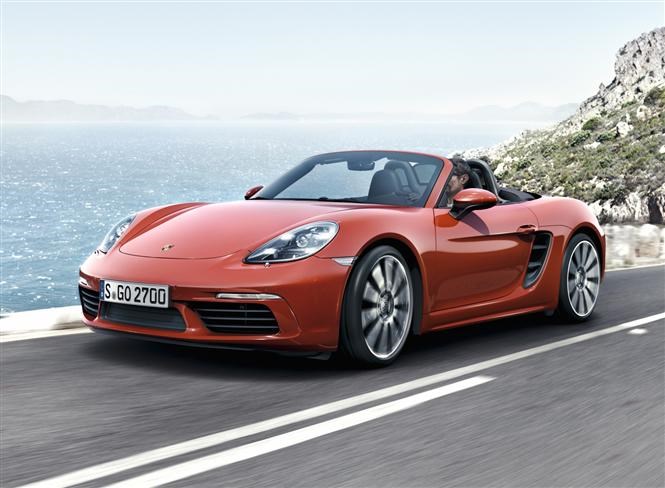There’s more to the Porsche 718 Boxster than a name harking back to a 1950s racer from the firm’s back catalogue – in case you’re wondering, Porsche protocol is to say Seven-Eighteen.
Look closely and you’ll spot the refreshed bodywork and spangly, new LED-laden lights but even more important is what you can’t see. Hidden at the 718 Boxster’s heart is a pair of new four-cylinder, turbocharged engines.
Not that such an overhaul means Porsche’s got the premium roadster market all to itself. There’s the recently facelifted Mercedes-Benz SLC-Class, stylish Audi TT Roadster and the big-engined Jaguar F-Type Convertible to contend with.
Turbocharging for torque and efficiency
Downsizing’s a trend across the motor industry so it’s no surprise that even mighty Porsche has succumbed to smaller-capacity engines. We’ve already seen a turbocharged 3-litre installed in the rear of the Porsche 911 Carrera where a naturally aspirated once 3.8 resided.
With the 718 Boxster, the changes are even more dramatic. Out go the previous 2.7- and 3.4-litre units of the Boxster and Boxster S, replaced by turbocharged, horizontally-opposed four-cylinder powerplants in 2- and 2.5-litre guises, respectively.
Both engines have gained an additional 34bhp over their predecessors, with the standard 718 Boxster up to 296bhp, the faster S version producing 345bhp.
Even more impressive is the torque output. Not only do the figures rise by 100Nm to 380Nm from 1,950rpm for the 718 Boxster and 60Nm to 420Nm at 1,900rpm for the S, turbocharging – with variable geometry on the S – ensures its delivery is more linear through to 4,500rpm, making the engines far more flexible.
Nevertheless, Porsche’s worked hard to ensure the engines will still gleefully rev up to 7,500rpm and have been tuned to sound suitably throaty, particularly with the optional Sports Exhaust package.
Specify the 718 with the optional Sports Chrono Package and PDK automatic gearbox, as Porsche expects most customers to do, and both versions are riotously rapid.
While the 718 Boxster S will reach 177mph and cover the 0-62mph sprint in 4.2 seconds, its less expensive sibling will still touch 170mph and hit 62mph from a standstill in 4.7 seconds – that’s a tenth of a second quicker than the outgoing Boxster S.
In spite of that accelerative urgency, Porsche’s engineers have also been keen to improve the 718 Boxster’s efficiency, with a claimed average fuel consumption of 40.9mpg and 38.7mpg for the S. Emissions are rated at between 158g/km and 184g/km of CO2, depending on the engine and gearbox combination.
Revised 718 Boxster styling
A casual glance may suggest otherwise, but all the 718 Boxster’s exterior is new save for the fabric roof and bootlid.
More pronounced edges on the front and rear wings make them appear taller and broader, a theme emphasised a tad heavy-handedly at the back.
The revised tail lights no longer blend seamlessly into the rear spoiler, instead a gloss black applique with a 3D Porsche script nestles below the electrically operated wing. Thankfully, the modified diffuser below it is more pleasing.
Up front, Porsche’s ‘four-point’ day running light signature is now incorporated within the headlamps, while the grilles in the front bumper have been widened.
Climb into the 718 Boxster’s superbly-built cabin and there are even fewer tweak to distinguish the latest iteration. Most obvious alterations centre upon the revised infotainment system and ovular air vents. Keener pilots may splash out extra on the smaller 360mm diameter steering wheel, previously seen on the Boxster Spyder.
Substantial chassis modifications
Underneath the sharpened exterior, the Porsche 718 Boxster’s undergone an extensive overall with improvements to the suspension, steering and brakes.
At the rear is an additional brace to improve the suspension’s rigidity making the 718 even more predictable at the limit. This can be further enhanced with Porsche Active Suspension Management (PASM) which is 10mm lower than standard; a new 20mm lower option with the Boxster S’s Sports Chassis.
Assisting with transmitting that additional power and torque to the road, the 718’s optional 20-inch wheels are now 10.5 inches wide at the back.
As with the latest 911 series, the 718 Boxster’s Sport Chrono control moves from behind the gear lever to a rotary dial mounted on the steering wheel. Porsche claims to have introduced a greater degree of differentiation between the modes, something we’ll explore further when we road test the newcomer.
Porsche’s fitted the 911 Turbo’s electrically-assisted steering set-up to the 718 Boxster making it 10 percent more agile but also claimed to be lighter while operating at lower speeds. This is further supplemented by a torque vectoring system which not only modulates the degree of power sent to the grippiest wheel or, but will introduce a degree of supplementary braking to amplify the effect.
To cope with the extra speed Porsche’s uprated the 718’s braking performance: as standard the Boxster gains the previous S’s brakes, while the new S adopts the four-piston callipers from the 911 Carrera. Six-piston carbon ceramic brakes remain an (expensive) option.
When can you buy one?
You can already order a 718 Boxster with deliveries expected from late April 2016 onwards.
We’ll be putting this faster and more fuel-efficient sports car to the test in a few weeks when we discover if the new Porsche 718 Boxster will still lead the roadster market.





